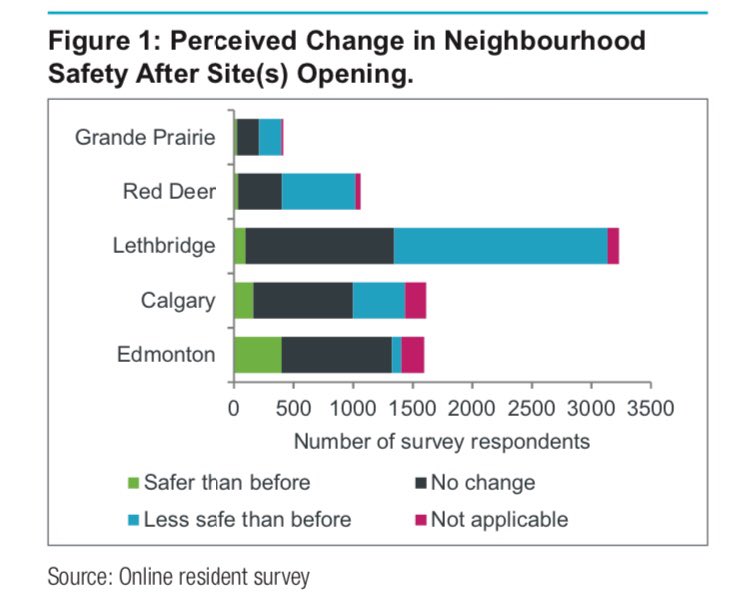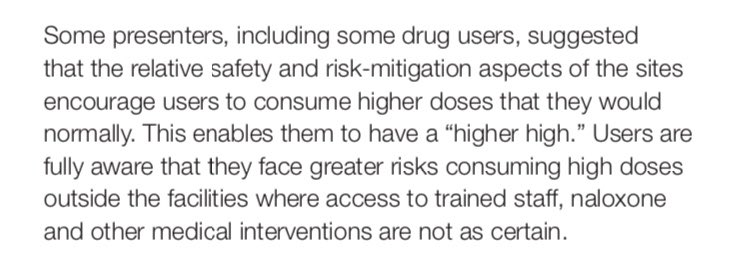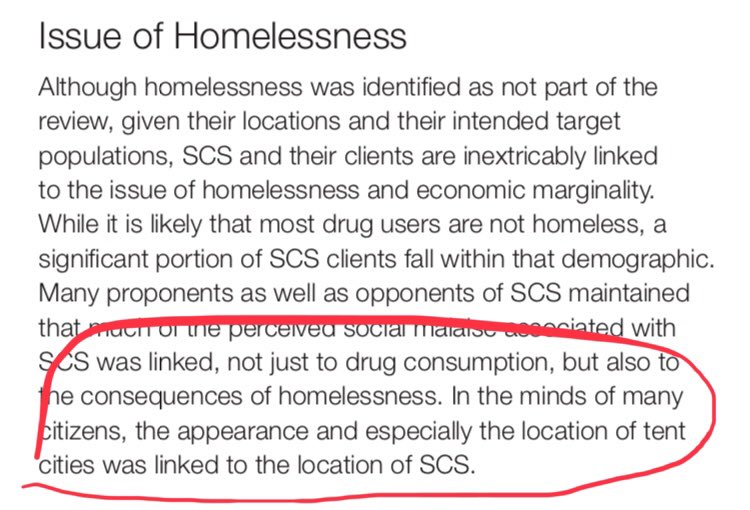Hear ye, hear ye!
Ye old #Alberta government has released its FLAWED, and GASLIT #SCS review report.
Associate Minister @jasonluan88 promised an unbiased perspective.
The only ones who look stupid here, are those of us who believed him.
#AbLeg
open.alberta.ca/publications/9…
Ye old #Alberta government has released its FLAWED, and GASLIT #SCS review report.
Associate Minister @jasonluan88 promised an unbiased perspective.
The only ones who look stupid here, are those of us who believed him.
#AbLeg
open.alberta.ca/publications/9…

Before we dive into the report, let’s talk about the Associate Minister and his esteemed panel for a moment.
Not a single member who has worked at or accessed an SCS; surely criminologists and retired cops will present an unbiased approach. 😒
alberta.ca/supervised-con…
Not a single member who has worked at or accessed an SCS; surely criminologists and retired cops will present an unbiased approach. 😒
alberta.ca/supervised-con…
Next, let’s see what the Ass. Minister has had to say about SCS and #harmreduction.
Surely his beliefs about Big Pharma funding research for harm reduction, and that #naloxone is an enabler couldn’t have impacted the committees viewpoints?

Surely his beliefs about Big Pharma funding research for harm reduction, and that #naloxone is an enabler couldn’t have impacted the committees viewpoints?


But what about the altruistic mandate of the SCS review panel?
Specifically out of scope of the review panel:
-“the merits of SCS as a harm reduction tool”
-“Other social issues such as housing and homelessness”
Because why would we measure any positive impacts?
Specifically out of scope of the review panel:
-“the merits of SCS as a harm reduction tool”
-“Other social issues such as housing and homelessness”
Because why would we measure any positive impacts?

Is this legal? Are we supposed to be sympathetic to a group of people ‘installing razor blades under door handles’?
This. Report. Is. A. Sham.
This. Report. Is. A. Sham.

Well there’s no shortage of unnecessary and blown out data in this report; here we have a fancy graph that should teach us one thing:
Siri show me ‘Observer-Expectancy Effect’
Researcher: Hey Tom, d’ya think crime is up?
Tom: umm...ya
Researcher: perfect thanks!
Siri show me ‘Observer-Expectancy Effect’
Researcher: Hey Tom, d’ya think crime is up?
Tom: umm...ya
Researcher: perfect thanks!

Some people don’t use opioids...and they still access SCS.
So the GoA would now like to scapegoat those people because they apparently don’t deserve a safe and supportive environment.
Fun fact: Fentanyl is hiding in meth too, you clowns.
So the GoA would now like to scapegoat those people because they apparently don’t deserve a safe and supportive environment.
Fun fact: Fentanyl is hiding in meth too, you clowns.

“Unless the substance is adulterated, methamphetamine users are generally at less risk of dying from overdose”
WHAT?! Unless the substance is adulterated?
So they should just take their chances on the street, is that right?
Translation: people who use drugs don’t deserve care.
WHAT?! Unless the substance is adulterated?
So they should just take their chances on the street, is that right?
Translation: people who use drugs don’t deserve care.

Glad we dusted off the old adage that Harm Reduction enables higher risk behaviour.
This has only been disproved countless times—but this government will forgo evidence because ‘some presenters’ said so.
This. Is. Not. How. Evidence. Works.
This has only been disproved countless times—but this government will forgo evidence because ‘some presenters’ said so.
This. Is. Not. How. Evidence. Works.

Here’s another utterly useless graph for you visual learners. That extra low dark blue bar? That’s a city that doesn’t have an SCS.
Could it be? Are we in an economic downturn?
This is called a confounding variable; this graph is useless. Much like this panel.
Could it be? Are we in an economic downturn?
This is called a confounding variable; this graph is useless. Much like this panel.

Here we have a statement that 40% of @ARCHESLeth staff are ‘addicts in recovery’ and this is somehow a bad thing?
Does the panel realize that many people who work in addictions have lived and living experience?
This is a fishing expedition, with Capt. Luan at the helm.
Does the panel realize that many people who work in addictions have lived and living experience?
This is a fishing expedition, with Capt. Luan at the helm.

Hey #Alberta were you wondering if you could put a price on Human Life?
This panel did.
$432/ unique client. That’s too much money if you are someone with an addiction according to this panel.
This panel did.
$432/ unique client. That’s too much money if you are someone with an addiction according to this panel.

Hilariously this is an argument in favour of SCS. $47 per visit.
The alternative however, is $200-400/ ambulance trip and upwards to $1500 / emergency department utilization.
But no go on, tell us how 47 bucks per visit is breaking our economy.
The alternative however, is $200-400/ ambulance trip and upwards to $1500 / emergency department utilization.
But no go on, tell us how 47 bucks per visit is breaking our economy.

Homelessness was not part of this review. But we found some way to use homelessness as a talking point against SCS, so we will make an exception.
Translation: some people didn’t like visible poverty, so we are going to target the homeless even further.
Translation: some people didn’t like visible poverty, so we are going to target the homeless even further.

Wow. What the actual f**k?
A) people who inject stimulants are at risk of HIV/HCV
B) when inhalation is offered, risk decreases because it is way safer than injection
C) people who use meth do not deserve to be vilified this way
A) people who inject stimulants are at risk of HIV/HCV
B) when inhalation is offered, risk decreases because it is way safer than injection
C) people who use meth do not deserve to be vilified this way

But holy shit.
This review panel perpetuated a stigmatizing and misinformed title like ‘government-supported crack houses’?
This is the group of ‘professionals’ we are supposed to believe?
This is shameful rhetoric formatted to look academic. It is fraud.
This review panel perpetuated a stigmatizing and misinformed title like ‘government-supported crack houses’?
This is the group of ‘professionals’ we are supposed to believe?
This is shameful rhetoric formatted to look academic. It is fraud.

Phew! I was worried nobody would mention #RuleOfLaw in this report! But we did it, we squeezed in just enough rhetoric!
Oh wait. SCS are legal and operate under exemption from the CDSA as determined by the federal government.
But please, tell us what one resident said again.
Oh wait. SCS are legal and operate under exemption from the CDSA as determined by the federal government.
But please, tell us what one resident said again.

So now we get to the recommendations, and while I won’t spend time with every one of them, I will say most of them are fundamentally flawed. Here are some examples!
Exhibit A: let’s bring in coercive treatment models into low-barrier services!
Exhibit A: let’s bring in coercive treatment models into low-barrier services!

Exhibit B:
#MedicineHat and #Calgary Forest Lawn don’t need consumption sites.
Sure, I mean, people are dying there too but screw em’ ammarite?
#MedicineHat and #Calgary Forest Lawn don’t need consumption sites.
Sure, I mean, people are dying there too but screw em’ ammarite?

Exhibit C: let’s re-shape our needle exchange protocols! This is undoubtedly an ode to the old 1:1 exchange policies that increased HIV/HCV transmission rates in the past. 

But it’s not all bad news: the panel at least acknowledged that people have a fundamental right to public washrooms. No argument here.
Pretty terrible this suggestion is being made to support businesses and residents, not the poor people having to go to the bathroom outside.
Pretty terrible this suggestion is being made to support businesses and residents, not the poor people having to go to the bathroom outside.

In summary, this report belongs in the garbage bin.
It is trash.
The panel is trash.
The premise is trash.
@jasonluan88 you should be ashamed of this witch hunt, but I guess.... promises made, promises kept.
It is trash.
The panel is trash.
The premise is trash.
@jasonluan88 you should be ashamed of this witch hunt, but I guess.... promises made, promises kept.

Also, can we talk about how you gave a hate-mongering post-media troll access to this report before anyone else?
Do you even know what transparency is?
Do you even know what transparency is?

To the rest of #Alberta, please do not give up on SCS or #HarmReduction.
Supervised consumption services:
✅Reduce overdose death
✅Decrease HIV/HCV transmissions
✅Increase access to health and social services
✅Decrease public drug consumption
#AbLeg #ABpoli
Supervised consumption services:
✅Reduce overdose death
✅Decrease HIV/HCV transmissions
✅Increase access to health and social services
✅Decrease public drug consumption
#AbLeg #ABpoli

• • •
Missing some Tweet in this thread? You can try to
force a refresh










